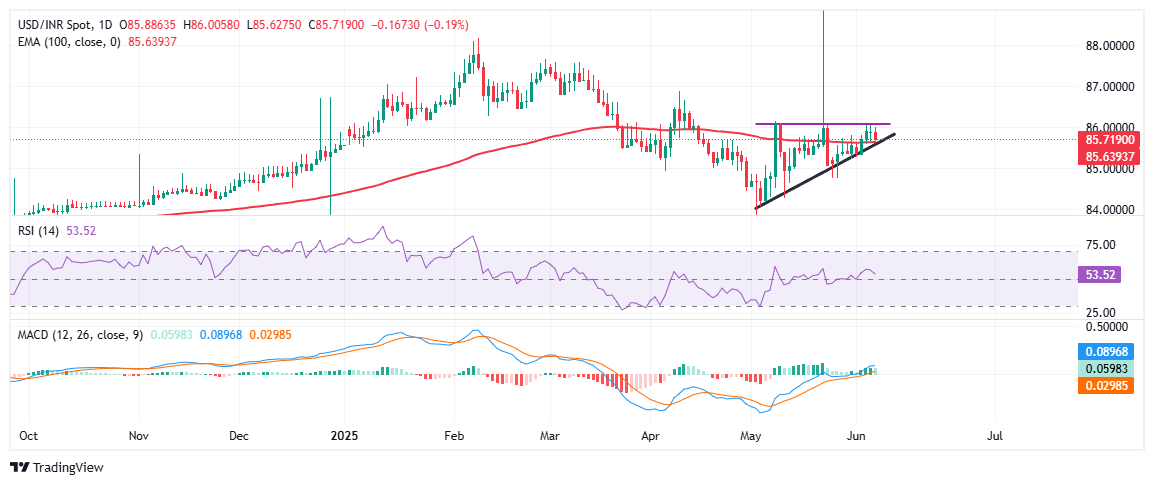Created
: 2025.06.06














![]() 2025.06.06 21:18
2025.06.06 21:18
The Indian Rupee (INR) strengthens slightly against the United States Dollar (USD) on Friday, despite a surprise 50-basis-point (bps) interest-rate cut by the Reserve Bank of India (RBI). The rate trim, which exceeded market expectations, briefly overshadowed a resilient Greenback ahead of the US Nonfarm Payrolls data.
At the time of writing, USD/INR trades around 85.73, down nearly 0.30% on the day, hovering near Thursday's low after pulling back from the intraday high of 86.00.
The Reserve Bank of India (RBI) surprised markets on Friday by cutting its benchmark repo rate by 50 basis points to 5.50%, opting for a stronger dose of monetary easing than the widely expected 25 bps move.
This is the third straight rate cut this year, signaling the central bank's growing urgency to revive domestic demand and support the economy. Alongside the repo rate cut, the RBI also reduced the Cash Reserve Ratio (CRR) by 100 bps to 3%, injecting fresh liquidity into the banking system.
During the press briefing, RBI Governor Sanjay Malhotra emphasized that frontloading monetary easing is the best way to cushion the economy while inflation stays well within target.
The RBI's updated projections showed a downward revision in inflation expectations, giving the central bank more flexibility to lower borrowing costs. Even with a shift from "accommodative" to a "neutral" stance, the overall tone suggested that the central bank is prepared to act again if needed.

Following the Reserve Bank of India's surprise 50-basis-point interest rate cut, USD/INR pulled back from the 86.00 mark and is now trading near 85.73.
The pair is trading just below the key resistance zone near 86.00 after multiple failed attempts to break higher. The pair remains supported by a short-term ascending trendline, which has been respected since early May, indicating persistent buying interest on dips. The 100-day Exponential Moving Average (EMA), currently at 85.63, is providing additional support. A daily close below this EMA could open the door for a deeper pullback toward 85.30 and possibly 85.00.
On the momentum side, the Relative Strength Index (RSI) holds steady around 53.5, suggesting that there is still room for either direction without signaling overbought or oversold conditions.
The Moving Average Convergence Divergence (MACD) remains in bullish territory, with the MACD line above the signal line, hinting at underlying upward bias. A confirmed breakout above 86.00 could expose the April highs below 87.00, while a failure to hold above the rising trendline may shift the near-term bias back in favor of INR strength.
The role of the Reserve Bank of India (RBI), in its own words, is "..to maintain price stability while keeping in mind the objective of growth." This involves maintaining the inflation rate at a stable 4% level primarily using the tool of interest rates. The RBI also maintains the exchange rate at a level that will not cause excess volatility and problems for exporters and importers, since India's economy is heavily reliant on foreign trade, especially Oil.
The RBI formally meets at six bi-monthly meetings a year to discuss its monetary policy and, if necessary, adjust interest rates. When inflation is too high (above its 4% target), the RBI will normally raise interest rates to deter borrowing and spending, which can support the Rupee (INR). If inflation falls too far below target, the RBI might cut rates to encourage more lending, which can be negative for INR.
Due to the importance of trade to the economy, the Reserve Bank of India (RBI) actively intervenes in FX markets to maintain the exchange rate within a limited range. It does this to ensure Indian importers and exporters are not exposed to unnecessary currency risk during periods of FX volatility. The RBI buys and sells Rupees in the spot market at key levels, and uses derivatives to hedge its positions.
![]()
Created
: 2025.06.06
![]()
Last updated
: 2025.06.06

FXStreet is a forex information website, delivering market analysis and news articles 24/7.
It features a number of articles contributed by well-known analysts, in addition to the ones by its editorial team.
Founded in 2000 by Francesc Riverola, a Spanish economist, it has grown to become a world-renowned information website.
We hope you find this article useful. Any comments or suggestions will be greatly appreciated.
We are also looking for writers with extensive experience in forex and crypto to join us.
please contact us at [email protected].
Disclaimer:
All information and content provided on this website is provided for informational purposes only and is not intended to solicit any investment. Although all efforts are made in order to ensure that the information is correct, no guarantee is provided for the accuracy of any content on this website. Any decision made shall be the responsibility of the investor and Myforex does not take any responsibility whatsoever regarding the use of any information provided herein.
The content provided on this website belongs to Myforex and, where stated, the relevant licensors. All rights are reserved by Myforex and the relevant licensors, and no content of this website, whether in full or in part, shall be copied or displayed elsewhere without the explicit written permission of the relevant copyright holder. If you wish to use any part of the content provided on this website, please ensure that you contact Myforex.
Myforex uses cookies to improve the convenience and functionality of this website. This website may include cookies not only by us but also by third parties (advertisers, log analysts, etc.) for the purpose of tracking the activities of users. Cookie policy